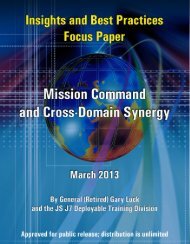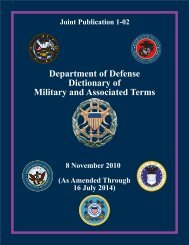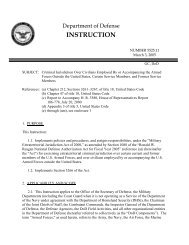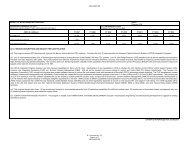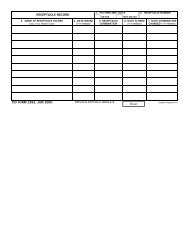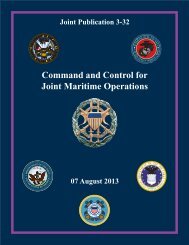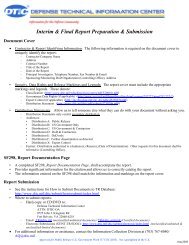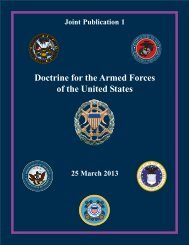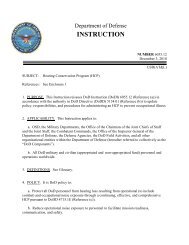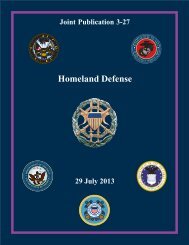JP 3-16, Multinational Operations - Defense Technical Information ...
JP 3-16, Multinational Operations - Defense Technical Information ...
JP 3-16, Multinational Operations - Defense Technical Information ...
Create successful ePaper yourself
Turn your PDF publications into a flip-book with our unique Google optimized e-Paper software.
Command and Coordination Relationships<br />
staff with linguists and requisite communications capabilities to maintain contact with their<br />
parent HQ. Apart from a central MNCC such as the CCC, a number of functional<br />
coordination centers may also be established within an overall combined logistics<br />
coordination or support command for a multinational operation. Activities centrally<br />
coordinated or controlled by such centers would include movement control, centralized<br />
operational contract support, theater-level logistic support operations, overall medical<br />
support, and infrastructure engineering. One key to the success of such centers is the early<br />
establishment and staffing with functionally skilled personnel to exercise appropriate control<br />
of designated activities.<br />
For additional guidance on organizing and manning an MNCC, refer to the <strong>Multinational</strong><br />
Planning Augmentation Team (MPAT) <strong>Multinational</strong> Force (MNF) Standing Operating<br />
Procedures (SOP). The MNF SOP can be viewed and downloaded from:<br />
https://community.apan.org/mpat/p/sop.aspx.<br />
7. Control of <strong>Multinational</strong> <strong>Operations</strong><br />
The degree of control exercised in an MNF is dictated by the MNF structure and the<br />
command relationships between members of the MNF. In general, the more centralized the<br />
command structure, the greater the MNF’s ability to achieve unity of effort. Integrated<br />
command structures, operating within their alliance framework, afford the greatest degree of<br />
control. A parallel structure, with its separate lines of command, typically offers the least<br />
control and ability to achieve unity of effort. LN structures can exhibit a wide range of<br />
control depending on the command relationships assigned.<br />
8. Interorganizational Coordination<br />
a. In many operating environments, the MNF interacts with a variety of entities<br />
requiring unified actions by the MNFC, including nonmilitary governmental departments<br />
and agencies, IGOs, and NGOs. These groups play an important role in providing support to<br />
HNs. Additionally, the MNF should be aware of private sector firms (e.g., businesses,<br />
contractors working for the military) operating in the OA. Though differences may exist<br />
between military forces and civilian agencies, short-term objectives are frequently very<br />
similar. CA or NATO civil-military cooperation (CIMIC) forces enhance interorganizational<br />
coordination through the establishment of a CMOC.<br />
b. Relationships. The MNFC’s relationship with these organizations will vary<br />
depending on the nature of the contingency and the particular type of organization involved.<br />
(1) Relationships with other governmental agencies (US and multinational<br />
partners) and IGOs should be clearly defined in order to achieve coherent coordination. It is<br />
important that interorganizational relationships be clearly defined with respect to required<br />
military support before commencement of operations, if possible. In some cases, other<br />
agencies may be lead agent for operations with military forces providing support. In other<br />
cases, the lead agency is prescribed by law or regulation, or by agreement between allied and<br />
coalition forces and the agencies involved. The President, normally through the Secretary of<br />
II-15



